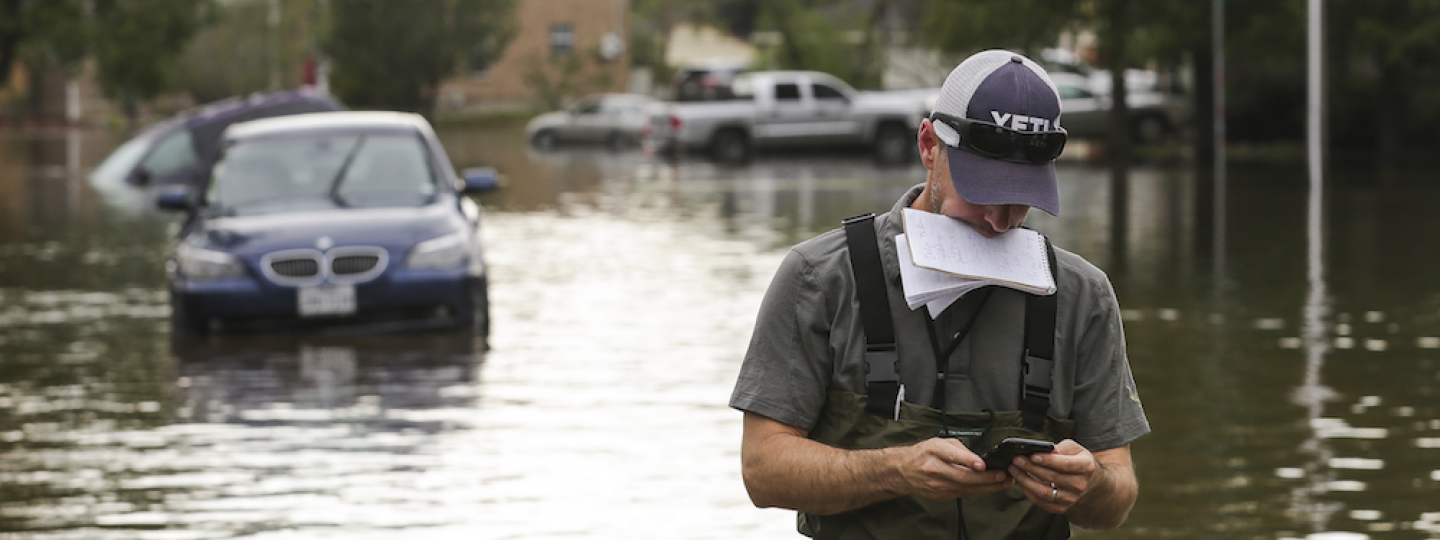In the midst of a nearly unprecedented hurricane season, as yet another made its way toward Puerto Rico and the U.S. Virgin Islands, one editor whose newsroom recently covered Hurricane Harvey gathered a short list of how they did it.
Vernon Loeb, managing editor of the Houston Chronicle, shared his 13 tips at a gathering of the Knight-Lenfest Table Stakes initiative newsrooms in Seattle. (Disclosure: The Knight Foundation funds my job covering local innovation. Poynter also receives funding from the Lenfest Institute.)
Loeb shared those tips and the stories behind them with us, too.
Here's what worked in Houston:
1. Prepare early, and make sure the "All Hands on Deck" expectation is clear.
The day before the storm made landfall in Rockport, Texas, Loeb sent out an email that explained what was coming and what was expected of staff.
"ALL HANDS ON DECK: Harvey is shaping up to be a very serious weather emergency," he wrote in the email. "Unless you are on vacation and out of town, everyone on the staff is on call and is expected to be available for assignment. Be available by cell phone at all times. You will not be expected to come to the office, which in the event of severe flooding may not be accessible. Begin by reporting in your community, and be available to be deployed elsewhere in the region, to the extent roads are passable. For those scheduled to be in the office, check conditions before leaving for work."
He included other details to help everyone prepare. They included:
– Taking laptops home and practicing getting into the system remotely.
– Making sure cars were full of gas and people could charge their phones using their cars. "In the event the region loses power, your car becomes your power plant," he wrote.
– How to file and whom to contact if regular editors couldn't be reached.
– To stand by: "We’ll keep you posted throughout the day tomorrow," Loeb wrote in the email. "Currently, the hurricane is forecast to make landfall north of Corpus Christi on Friday night and could stall over the Houston region for as long as 3-5 days, dropping 30 inches of rain or more. This is the worst case scenario, which could mean major flooding, thousands of homes damaged or underwater, and a loss of power."
2. Be mobile and distributed. Sometimes not being able to get to the office is a blessing in disguise.
On Sunday morning, as the waters rose in Houston, Loeb sent out an email titled "Full staff activation." The note instructed staff to get in touch with their editors. "Assess the roads in your community, begin reporting there and await further instructions."
3. Prepare yourself psychologically for what you're about to do …
The day before the storm hit, Loeb brought a sleeping bag and inflatable bed to the newsroom and bought four days worth of sandwiches at Trader Joe's so that he could focus on running the coverage.
"… In our case, cover the millennial inundation of our homes and neighborhoods – and prepare for life without any creature comforts for days," Loeb wrote, "so that you can fully immerse yourself in what you need to do as a journalist."
4. Experience the story, and the hurricane conditions, at least a little, so you have a sense as an editor what your reporters, and ordinary citizens, are dealing with.
"Because I'd stashed my car on the third floor of the business editor's parking garage the day before the storm hit, I was forced to walk/run to work during the worst days of the storm, when I couldn't have driven anyway," Loeb wrote. "I took pictures on my iPhone as I made my way into the office, which I found very helpful. I was reporting with my eyes and getting a very real sense of conditions on the street."
5. Once you get going, select really strong designated ledeall writers for the newspaper and the web – don't think one person can do both.
In the first three days, Loeb figured out who would write the ledealls for day and night shifts. They also used two web writers per shift to update the story and the "Here's what we know now" stream.
That stream was updated 1,500 times throughout the storm, Loeb said.
6. Start a vignette stream with a dedicated editor.
"Reporters loved writing them, and our vignettes immediately gave everyone a way to contribute – and contribute they did," Loeb wrote. "Staff members wrote over a hundred in four days. Read now back to back, they produce an incredible, panoramic sense of the storm."
7. Invest early in enterprise and keep those resources walled off.
On the second day of the storm, Loeb called his three best reporters and told them to start working on a narrative for that Sunday's newspaper.
"One of my three writers had been evacuated from his home, and another accepted this assignment while watching floodwater creep up to his front door. But all three embraced the job and wrote an extraordinary, 6,500-word narrative, '51 Inches.' It ran over three full pages of the Sunday paper, and had a stunning online presentation."
Commit resources to enterprise at the beginning, Loeb said, instead of the end.
8. In addition to the web and long-form enterprise, focus on utility – road closures, shelter locations, evacuations, restaurants open, medical facilities open, school closures, grocery stories, power outages, insurance tips, where to donate, and a rolling forecast.
Early on, a senior editor, Laura Goldberg, was put in charge of a utility team. She assigned one reporter to each of those topics.
"As the storm progressed, the utility coverage shifted from emergencies to recovery," Loeb wrote.
9. Pay attention to scheduling early, and rough out round the clock staffing, making sure you've got reporters working overnight, and that you're pretty robustly staffed by 5 a.m. when web traffic starts to surge again in the morning.
"We had to pull people from every staff to make this happen, and obviously ask people to get way outside their comfort zones in terms of their hours," Loeb wrote. "I'd never seen people pull so many all-nighters since college."
10. Once you get people in place, keep them there so that you're staffed to cover the story wherever it moves or morphs, even after they start agitating to come back in. This gets back to being mobile, distributed – and abandoning all creature comforts.
"We had a couple of reporters out in suburban regions who hadn't changed clothes in days, had been kicked out of their hotel rooms, and weren't all that happy," Loeb wrote. "But the rivers hadn't crested in those counties, and we knew that when and if they did, that's where the height of the story would be. So we told our people to stay where they were – we couldn't have replaced them, even we wanted to. They understood, hunkered down and got the job done."
11. Watch local TV — all the channels.
Loeb sat in the web hub with three TV monitors turned to local channels, plus a few national cable news apps on his iPad.
"The TV stations did what TV does best – they had reporters standing knee or waste deep in water in neighborhoods all over the city, which enabled me to understand where the hot spots were, and where we needed to send reporters," Loeb wrote. "They also covered all the relevant press conferences live – the mayor's, the governor's and the Harris County Flood Control District's. And this enabled me to have a good feel for major themes and what should be included high up in our ledealls. I often took quotes and passed them along to the writers. We had reporters at all these locations asking questions, but I could get immediate quotes in the hands of our web writers faster than they could."
12. Feed the troops.
"On Friday night, just as the storm was making landfall 190 miles away in Rockport, my friend Valerie Strauss at the Washington Post sent me a text: 'Make sure the newsroom has food and water.' I told her we had booked 15 hotel rooms we ended up not needing," Loeb wrote. "And she replied: 'U really have to have food and water in the newsroom.'"
She was right.
The Chronicle got food and care packages from other newsrooms around the country: The Washington Post, The Philadelphia Inquirer, The New York Times, the Dallas Morning News, the Asian American Journalists Association, the San Francisco Chronicle, the Salt Lake Tribune, the Press Club of New Orleans, the Tampa Bay Times, CCI, Pro Publica, the Orlando Sentinel, the Baton Rouge Advocate, the Times Picayune, the Minneapolis Star-Tribune Newspaper Guild, the Tennessean, the Oklahoman, the Colorado Spring Gazette, the Pittsburgh Post-Gazette and Guild, the Seattle Times and the Omaha World-Herald.
"This support meant so much to us," he wrote, "and we were so, so grateful."
13. Praise your staff every morning for good performance, especially when people are out there making incredible sacrifices to make it happen.
"We paid 1,100 hours of overtime, and were happy to do it, but this praise for a job well done, I think, was in some ways worth even more than money for our staff members," Loeb wrote. "What was so gratifying for me was watching how our staff surged to cover Hurricane Harvey. There wasn't a single person who had to be arm-twisted or cajoled to join the effort. For many, it was the opposite — we simply couldn't make them stop working. It was almost as though they all sensed this was their moment to take back the journalism narrative from these people yammering about fake news, and they did so."









